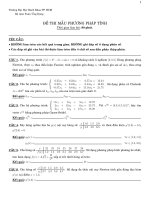ch11.ppt
Bạn đang xem bản rút gọn của tài liệu. Xem và tải ngay bản đầy đủ của tài liệu tại đây (623.93 KB, 55 trang )
Chapter 11: File System
Chapter 11: File System
Implementation
Implementation
11.2
Silberschatz, Galvin and Gagne ©2005
Operating System Concepts – 7
th
Edition, Jan 1, 2005
Chapter 11: File System Implementation
Chapter 11: File System Implementation
File-System Structure
File-System Implementation
Directory Implementation
Allocation Methods
Free-Space Management
Efficiency and Performance
Recovery
Log-Structured File Systems
NFS
Example: WAFL File System
11.3
Silberschatz, Galvin and Gagne ©2005
Operating System Concepts – 7
th
Edition, Jan 1, 2005
Objectives
Objectives
To describe the details of implementing local file systems and
directory structures
To describe the implementation of remote file systems
To discuss block allocation and free-block algorithms and trade-offs
11.4
Silberschatz, Galvin and Gagne ©2005
Operating System Concepts – 7
th
Edition, Jan 1, 2005
File-System Structure
File-System Structure
File structure
Logical storage unit
Collection of related information
File system resides on secondary storage (disks)
File system organized into layers
File control block – storage structure consisting of information
about a file
11.5
Silberschatz, Galvin and Gagne ©2005
Operating System Concepts – 7
th
Edition, Jan 1, 2005
Layered File System
Layered File System
11.6
Silberschatz, Galvin and Gagne ©2005
Operating System Concepts – 7
th
Edition, Jan 1, 2005
A Typical File Control Block
A Typical File Control Block
11.7
Silberschatz, Galvin and Gagne ©2005
Operating System Concepts – 7
th
Edition, Jan 1, 2005
In-Memory File System Structures
In-Memory File System Structures
The following figure illustrates the necessary file system structures
provided by the operating systems.
Figure 12-3(a) refers to opening a file.
Figure 12-3(b) refers to reading a file.
11.8
Silberschatz, Galvin and Gagne ©2005
Operating System Concepts – 7
th
Edition, Jan 1, 2005
In-Memory File System Structures
In-Memory File System Structures
11.9
Silberschatz, Galvin and Gagne ©2005
Operating System Concepts – 7
th
Edition, Jan 1, 2005
Virtual File Systems
Virtual File Systems
Virtual File Systems (VFS) provide an object-oriented way of
implementing file systems.
VFS allows the same system call interface (the API) to be used for
different types of file systems.
The API is to the VFS interface, rather than any specific type of file
system.
11.10
Silberschatz, Galvin and Gagne ©2005
Operating System Concepts – 7
th
Edition, Jan 1, 2005
Schematic View of Virtual File System
Schematic View of Virtual File System
11.11
Silberschatz, Galvin and Gagne ©2005
Operating System Concepts – 7
th
Edition, Jan 1, 2005
Directory Implementation
Directory Implementation
Linear list of file names with pointer to the data blocks.
simple to program
time-consuming to execute
Hash Table – linear list with hash data structure.
decreases directory search time
collisions – situations where two file names hash to the same
location
fixed size
11.12
Silberschatz, Galvin and Gagne ©2005
Operating System Concepts – 7
th
Edition, Jan 1, 2005
Allocation Methods
Allocation Methods
An allocation method refers to how disk blocks are allocated for
files:
Contiguous allocation
Linked allocation
Indexed allocation
11.13
Silberschatz, Galvin and Gagne ©2005
Operating System Concepts – 7
th
Edition, Jan 1, 2005
Contiguous Allocation
Contiguous Allocation
Each file occupies a set of contiguous blocks on the disk
Simple – only starting location (block #) and length (number
of blocks) are required
Random access
Wasteful of space (dynamic storage-allocation problem)
Files cannot grow
11.14
Silberschatz, Galvin and Gagne ©2005
Operating System Concepts – 7
th
Edition, Jan 1, 2005
Contiguous Allocation
Contiguous Allocation
Mapping from logical to physical
LA/512
Q
R
Block to be accessed = ! + starting address
Displacement into block = R
11.15
Silberschatz, Galvin and Gagne ©2005
Operating System Concepts – 7
th
Edition, Jan 1, 2005
Contiguous Allocation of Disk Space
Contiguous Allocation of Disk Space
11.16
Silberschatz, Galvin and Gagne ©2005
Operating System Concepts – 7
th
Edition, Jan 1, 2005
Extent-Based Systems
Extent-Based Systems
Many newer file systems (I.e. Veritas File System) use a modified
contiguous allocation scheme
Extent-based file systems allocate disk blocks in extents
An extent is a contiguous block of disks
Extents are allocated for file allocation
A file consists of one or more extents.
11.17
Silberschatz, Galvin and Gagne ©2005
Operating System Concepts – 7
th
Edition, Jan 1, 2005
Linked Allocation
Linked Allocation
Each file is a linked list of disk blocks: blocks may be scattered
anywhere on the disk.
pointerblock =
11.18
Silberschatz, Galvin and Gagne ©2005
Operating System Concepts – 7
th
Edition, Jan 1, 2005
Linked Allocation (Cont.)
Linked Allocation (Cont.)
Simple – need only starting address
Free-space management system – no waste of space
No random access
Mapping
Block to be accessed is the Qth block in the linked chain of
blocks representing the file.
Displacement into block = R + 1
File-allocation table (FAT) – disk-space allocation used by MS-DOS
and OS/2.
LA/511
Q
R
11.19
Silberschatz, Galvin and Gagne ©2005
Operating System Concepts – 7
th
Edition, Jan 1, 2005
Linked Allocation
Linked Allocation
11.20
Silberschatz, Galvin and Gagne ©2005
Operating System Concepts – 7
th
Edition, Jan 1, 2005
File-Allocation Table
File-Allocation Table
11.21
Silberschatz, Galvin and Gagne ©2005
Operating System Concepts – 7
th
Edition, Jan 1, 2005
Indexed Allocation
Indexed Allocation
Brings all pointers together into the index block.
Logical view.
index table
11.22
Silberschatz, Galvin and Gagne ©2005
Operating System Concepts – 7
th
Edition, Jan 1, 2005
Example of Indexed Allocation
Example of Indexed Allocation
11.23
Silberschatz, Galvin and Gagne ©2005
Operating System Concepts – 7
th
Edition, Jan 1, 2005
Indexed Allocation (Cont.)
Indexed Allocation (Cont.)
Need index table
Random access
Dynamic access without external fragmentation, but have
overhead of index block.
Mapping from logical to physical in a file of maximum size of
256K words and block size of 512 words. We need only 1
block for index table.
LA/512
Q
R
Q = displacement into index table
R = displacement into block
11.24
Silberschatz, Galvin and Gagne ©2005
Operating System Concepts – 7
th
Edition, Jan 1, 2005
Indexed Allocation – Mapping (Cont.)
Indexed Allocation – Mapping (Cont.)
Mapping from logical to physical in a file of unbounded
length (block size of 512 words).
Linked scheme – Link blocks of index table (no limit on
size).
LA / (512 x 511)
Q
1
R
1
Q
1
= block of index table
R
1
is used as follows:
R
1
/ 512
Q
2
R
2
Q
2
= displacement into block of index table
R
2
displacement into block of file:
11.25
Silberschatz, Galvin and Gagne ©2005
Operating System Concepts – 7
th
Edition, Jan 1, 2005
Indexed Allocation – Mapping (Cont.)
Indexed Allocation – Mapping (Cont.)
Two-level index (maximum file size is 512
3
)
LA / (512 x 512)
Q
1
R
1
Q
1
= displacement into outer-index
R
1
is used as follows:
R
1
/ 512
Q
2
R
2
Q
2
= displacement into block of index table
R
2
displacement into block of file:




![Moi gioi BAT DONG SAN 01[1].ppt](https://media.store123doc.com/images/document/12/gu/pr/medium_VqscYiF6ld.jpg)




